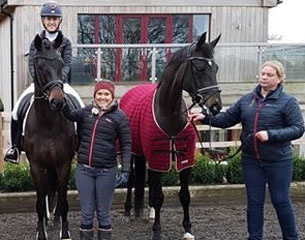
The recent 2017 British Dressage Young Horse Forums which took place over two Mondays in January have gone down a storm, providing an invaluable opportunity to learn from and share ideas with respected figures from within the sport.
The two training days held at Hurstbourne Equestrian, Hampshire (Monday 16 January) and Mount St John Stud in North Yorkshire (Monday 30 January) were dedicated exclusively to the training and healthy development of young dressage horses. Each day featured demonstrations with two horses of four, five and six years of age plus one seven-year-old to display everything from way of going to test riding.
At Hurstbourne we had pleasure in welcoming world renowned trainer Paul Fielder, BD Training Director Paul Hayler and FEI 5* Judge and rider Isobel Wessels as guest speakers. And the two Pauls returned for the Northern audience at Mount St John Stud where they were joined by former FEI Judge and highly respected breeder, rider and trainer, Jennie Loriston-Clarke MBE.
Within each session, the horses were ridden in pairs in front the audience whilst the presenters discussed what they saw. The experts’ insight revealed valuable tips and advice on developing the young horse to not only reach his potential, but to set him on the path to a long and healthy career as a happy dressage partner.
Some overriding messages from the two days:
- The horse must use his whole body not just the legs. He should move through the top line, over the back and using the ribcage.
- We don’t want to see a ‘mini Grand Prix horse' with a perfect contact 100% of the time, so long as the horse is round, ‘through’ and soft.
- It’s important to consider the longevity of the horse at all stages of training.
- If a horse isn’t ready for the age-relevant young horse tests, it doesn’t matter. Horses develop at different speeds and it’s not indicative of their future potential. Believe in your horse.
- For judging young horse tests, what’s more important – correctness or potential? If the judge follows the score sheet and marks what’s in front of them, the right result will be reached. If a correctly trained talented horse performs with marginal errors and a less talented horse performs with no errors, the more talented horse will come out on top.
- In a situation where the horse is tense and spooky, it’s the rider’s job to get the horse to refocus. Use lateral work and transitions to encourage the horse back on the aids. Influence the horse in a positive way.
- Allow the horse to stretch between exercises.
- Use shoulder-fore to balance the canter.
- Get your horse accustomed to being ridden by someone else in preparation for being ridden by the rider-judge.
- The rider-judge has to ask a lot from the horse in the given six minutes without pushing him out of his comfort zone.
- The rider-judge assessment can significantly affect the overall placings as what’s felt doesn’t always reflect what’s seen.
The way to a good walk:
- The aim is for the horse to be stretching to the contact and following the hand with a correct four-beat and good over-track.
- For a good medium walk, the rider’s hands must follow the movement of the horse so that he can use his neck.
- Ride half ten-metre circles to get lateral bend and encourage the horse to move through the ribcage.
- Ride serpentines and circles to encourage lateral bend and acceptance of the inside leg.
Tips for the trot:
- In the working trot, the horse must be ridden forwards and allowed to develop a true balance. The hind foot should step into the footprint of the fore foot at least.
- We want to see the back lifting and the horse working over the top line.
- Allow the horse to stay in balance with good impulsion.
Creating the canter
- An indicator of good placement of the hind leg in canter is that the inside hind leg lands inline with the shoulder-hip line of the rider.
- An active hind leg lifts the shoulder and gives more ‘air time’.
- Be brave and show a clear difference for the medium strides. Think of driving a car in sport mode. This also helps to sharpen the hind leg.
Q: In the test, should trot be ridden rising or sitting for four-year-olds?
A: Whichever is best to show off the horse. Generally, horses at this age swing through the back better if ridden rising. Some will ‘down gear’ if ridden sitting.
Q: What’s preferred, the poll as the highest point with some tension or the poll lower but softer?
A: The most important thing is that the horse is using his whole body. The higher poll comes with correct training, from impulsion and lift from the underline and shoulder.
Q: Is the FEI test for seven-year-olds (PSG level) too much of a jump from the six-year-old tests?
A: We shouldn’t be pushing horses to get to this level, but it’s there to showcase horses that have easily progressed and are ready.
Text by British Dressage
Related Links
British Dressage to Stage Two Young Horse Training Forums in 2017
Hawtins San Floriana, Mount St. John VIP, San Marco Win 2016 British Young Horse Championships
Mount St. John Sweeps 2016 British Dressage Championships